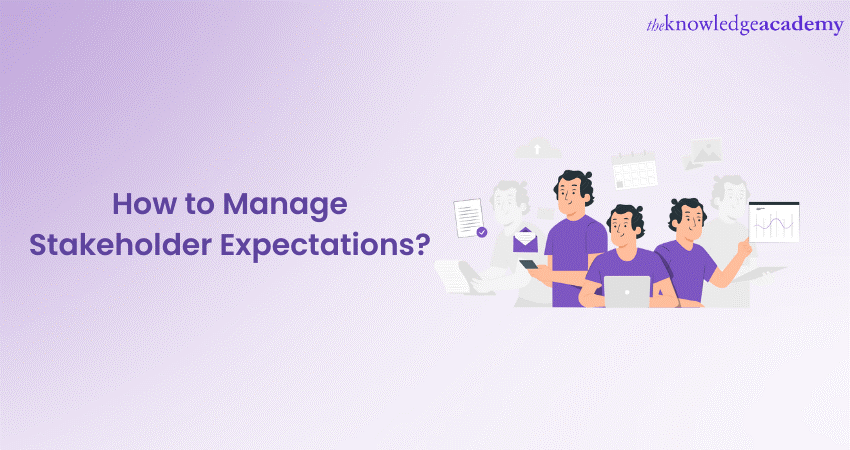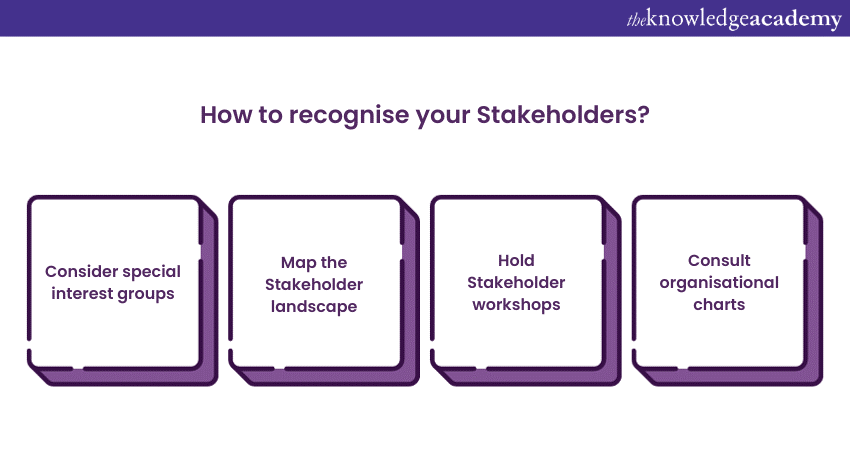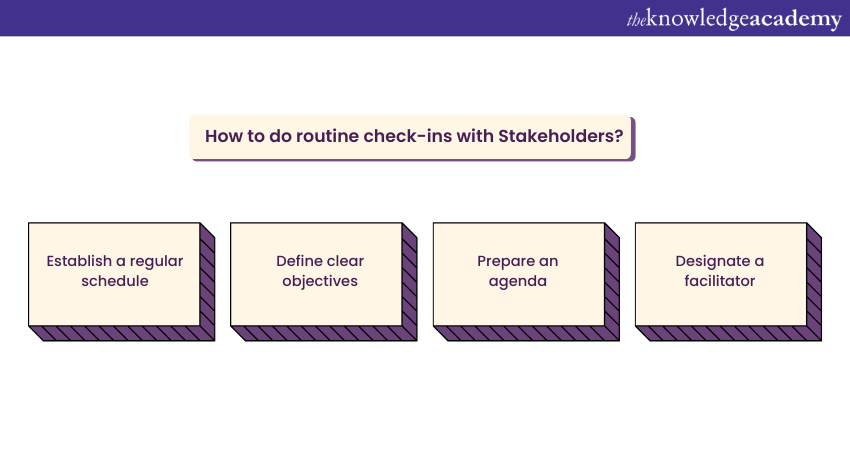We may not have the course you’re looking for. If you enquire or give us a call on +44 1344 203 999 and speak to our training experts, we may still be able to help with your training requirements.
We ensure quality, budget-alignment, and timely delivery by our expert instructors.

In Project Management, Stakeholders play a significant role in cross-functional projects, which is why any project's outcome depends on how Stakeholders are engaged and managed. Whether met or unmet, their Expectations become a deciding factor in the project's ultimate success. Therefore, a critical question arises: How to Manage Stakeholder Expectations?
Stakeholders possess different levels of influence, and their support or resistance can significantly impact the project's progress. Thus, it’s crucial for Project Managers and the members to find answers to this question. Worry no more. Read this blog to learn How to Manage Stakeholder Expectations so that you can transform potential obstacles into valuable contributions.
Table of Contents
1) Understanding the importance of Stakeholder Expectations
2) Tips on How to Manage Stakeholder Expectations
a) Recognise your Stakeholders
b) Understand Stakeholder needs
c) Set practical Expectations
d) Work on Stakeholder's engagement plan
e) Create a channel of communication
f) Do routine check-ins
g) Follow-up after important meetings
h) Measure progress
3) Conclusion
Understanding the importance of Stakeholder Expectations
It is not always possible to simultaneously satisfy the changing needs of all your Stakeholders. Project Managers often find a proper balance in a project, while there are clear winners and losers at other times. The importance of efficient Stakeholder Management also does not necessarily revolve around delivering all the minute aspects each Stakeholder desires. Instead, it is about guiding them through the process and offering them opportunities to influence outcomes.
Knowing the Stakeholder Expectations provides a fundamental framework for aligning project goals and outcomes. When an organisation meets or exceeds these expectations, it automatically increases the probability of project success and overall stakeholder satisfaction. These expectations also play a crucial role in resource distribution. Knowing what stakeholders expect allows organisations to distribute their resources in the most efficient way possible. Reviewing Stakeholder Management Interview Questions can help you understand how to identify and manage these expectations effectively, ensuring you can demonstrate your ability to align stakeholder needs with project outcomes during your interview.
On the other hand, not meeting Stakeholder Expectations can also lead to many difficulties. Issues like project delays, conflict among team members, and, in some cases, project failure. By proactively managing these Expectations early in the process, organisations can identify potential risks and address issues before they escalate.
Are you an aspiring Project Manager and looking to excel in the Project Management field? Register for our Project Management Courses!
Tips on How to Manage Stakeholder Expectations
Now that you are aware of the importance of managing Stakeholder Expectations, let us quickly jump into the tips that can help you along this process. Here's How to Manage Stakeholder Expectations:
Recognise your Stakeholder
Stakeholders come from various groups, including internal teams, external partners, customers, regulatory bodies, and the broader community. You can begin by asking your project team and relevant individuals to brainstorm and create a primary list of potential Stakeholders. Consider all parties who may have an interest in or may be affected by your project.
If available, you can also review existing project documentation, organisational charts, and Stakeholder databases. These sources can provide valuable insights into known Stakeholders, including internal terms, external partners, clients and regulations.
After identifying all the Stakeholders, you can categorise them based on their level of influence, interest, and relevance to the project. This categorisation helps prioritise engagement efforts and customise communication strategies to each group's unique characteristics. Here are some things that you should look out for:

Understand Stakeholder needs
Engagement with your Stakeholders on a regular basis is the first step to understanding Stakeholder's needs. This can include meetings, surveys, emails, phone calls, etc. Practising active listening during the engagement is another important aspect that can help you understand their needs. So, pay close attention to what they say and reach out for clarification when necessary.
Surveys are an efficient way to collect feedback from targeted Stakeholders. The right questions in a survey provide a structured format for respondents to share their opinions, preferences and experiences. It also provides a systematic collection of data on specific topics or issues.
For projects involving multiple teams or departments, encouraging cross-functional collaboration is important for understanding and addressing Stakeholder's needs. Different teams can offer insights into various aspects of Stakeholder's requirements.
Need more support with dealing with Stakeholders? Register for our Creating Effective Stakeholder Engagement Training!
Set practical Expectations
When Stakeholders have clear, realistic Expectations, a sense of transparency is cultivated in a project or a process. Being crystal clear about your goals and aspirations builds trust among Stakeholders. When Stakeholders trust that they are provided with honest information, they are more likely to invest in the project.
You can ask the Stakeholders about the results they expect from this project. Ask something like how they measure success. This can help you discover conflicting definitions of success. For some Stakeholders, success might be meeting the final deadlines; for others, it might be perfection in end-user functionality.
Practical Expectations also make the distribution of resources easier, such as time, budget, and manpower. When Stakeholders have realistic Expectations, resources can be distributed more efficiently, ensuring that they are used effectively to meet those Expectations.
Work on Stakeholder's engagement plan
A well-structured engagement plan summarises what the organisation or project aims to achieve through Stakeholder interactions. Revising and working on perfecting this plan offers alignment with overall goals. A plan developed with a structural framework helps outline steps, methods, and channels that will be used in the future. This creates a systematic and organised approach.
While plans provide structure, they should also be adaptable to changing circumstances. Practical plans allow flexibility and adjustments as new Stakeholder concerns or opportunities arise. A well-designed plan can even serve as a reference point for resolving disputes or conflicts. It outlines procedures for addressing disagreements and escalating matters when necessary.
Many industries have legal requirements for Stakeholder engagement. A well-documented plan ensures that organisations meet these obligations, which helps reduce legal risk.
Create a channel of communication
Communication channels provide a dedicated platform for sharing project updates, progress reports, important announcements, and relevant information with Stakeholders. This confirms that Stakeholders are appropriately informed about the project's status, objectives and changes.
Transparent communications build trust and confidence among Stakeholders. This is why accessing accurate and timely information makes them more likely to perceive the project or organisation as honest and accountable. If conflicts or disagreements occur, communication channels also offer a platform for Stakeholders to voice their concerns and grievances. Moreover, addressing issues before they become too big prevents disputes from escalating and negatively impacting the projects.
Communication channels also work on establishing a feedback loop that allows Stakeholders to provide input on project strategies, deliverables, and performance. This two-way communication ensures that the project remains responsive to changing circumstances.
Do routine check-ins

Stakeholders have a tendency to change their priorities and goals with time. Routine check-ins help to confirm that all Stakeholders remain aligned with the project's objectives. They help address adjustments and realignments to keep everyone on the same page.
Check-ins also provide an opportunity to track the project's progress and assess whether it is meeting Stakeholder Expectations and needs. It allows Stakeholders to gauge how their input has influenced the project's trajectory.
Maintaining consistent communication with Stakeholders helps in managing the reputation of an organisation by showing a commitment to transparency and accountability. Routine check-ins also offer timely decision-making since Stakeholders can provide input and make decisions collaboratively. This, in turn, helps reduce delays caused by prolonged decision-making.
Follow-up after important meetings
Important meetings are full of information and complications and can witness drastic changes. So, follow-up discussions, especially meeting minutes or summaries, provide Stakeholders with a clear, concise record of what was discussed, decisions made, and actions assigned. Individuals are more likely to fulfil their commitments when activities and responsibilities are documented and shared with Stakeholders. It also sets clear Expectations for follow-through and progress tracking.
During crises and emergencies, follow-up is crucial for informing Stakeholders about the situations, response efforts, and safety measures. It helps mitigate panic and uncertainty. Follow-up also allows one to repeat essential messages, such as the project's vision, goals, or core objectives. This repetition can reinforce Stakeholder buy-in and understanding.
Measure progress
Measuring progress provides a foundation for continuous improvements. By measuring progress, a project team can identify areas for enhancement and innovation by regularly reviewing progress data and seeking Stakeholder input.
On the other hand, Stakeholders who see positive progress reports are often motivated and engaged in the project. They are encouraged by visible results and are more likely to contribute actively to the project's success.
Comparing progress generates valuable documentation that can also be used for internal and external reporting. This documentation can be in the form of progress reports, charts, and data summaries that support informed decision-making. When a project reaches its conclusion, progress measurement also serves as a means of verifying that all objectives have been met. It provides a comprehensive record of accomplishments and deliveries, which can be valuable for project closure and Stakeholder satisfaction.
Conclusion
We hope that after reading this blog, you have understood How to Manage Stakeholder Expectations. Understanding that building strong Stakeholder relationships is essential for constructing bridges of trust. When Stakeholders feel heard, valued, and a sense of belonging, they are more likely to extend trust and cooperation.
Trying to figure out the key purpose of project management? Register for our Introduction To Project Management Certification Course!
Upcoming Business Analysis Resources Batches & Dates
Date
 ITIL® 4 Specialist: Drive Stakeholder Value Course
ITIL® 4 Specialist: Drive Stakeholder Value Course
Mon 17th Mar 2025
Mon 19th May 2025
Mon 21st Jul 2025
Mon 22nd Sep 2025
Mon 24th Nov 2025






 Top Rated Course
Top Rated Course



 If you wish to make any changes to your course, please
If you wish to make any changes to your course, please


